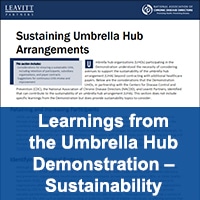Umbrella Hub Arrangements → Sustaining Umbrella Hub Arrangements
Sustaining Umbrella Hub Arrangements
A primary goal of an umbrella hub arrangement (UHA) is to create a sustainable arrangement for the umbrella hub organization (UHO) and each subsidiary. In the context of a UHA, sustainability typically refers to when the subsidiary organizations are receiving reimbursement for delivering the National Diabetes Prevention Program (National DPP) lifestyle change program from reliable reimbursement dollars that can be maintained over a protracted period of time, rather than relying on reimbursement from short-term funding, such as grant funding.
Having multiple health care payers for the National DPP lifestyle change program is essential for the sustainability of a UHA. UHOs are encouraged to enroll in the Medicare Diabetes Prevention Program (MDPP), Medicaid (if applicable), and contract with Medicaid managed care organizations (MCOs), Medicare Advantage (MA) plans, commercial health plans, and self-insured employers. To learn more, see the Reimbursement for Umbrella Hub Arrangements page of the Coverage Toolkit.
UHOs can also consider avenues to support the sustainability of the UHA in addition to contracting with health care payers. Organizations interested in applying to become a UHO are encouraged to develop and revisit a sustainability plan with their subsidiaries.
Below are considerations NACDD and Leavitt Partners identified that may contribute to the sustainability of the UHA.
Learnings from the Umbrella Hub Demonstration that correlate with this Coverage Toolkit page (learnings related to the sustainability of the UHA) are in the document titled, Learnings from the Umbrella Hub Demonstration – Sustainability. For all of the learnings from the Umbrella Hub Demonstration refer to the full document, Learnings from the Umbrella Hub Demonstration.
Address Participant Health-Related Social Needs and Coordinate Care
Since health-related social needs (HRSN), such as transportation or childcare, can influence whether an individual enrolls and remains in the program, strategic partnerships providing wrap around services can help increase participant enrollment and retention. UHAs have the potential to link participants to resources that reduce their risk of developing type 2 diabetes and address additional HRSN that may present as barriers. By addressing unmet HRSN and connecting participants to resources, UHOs and subsidiary organizations can improve health outcomes in the community and increase sustainability of the UHA. For additional information on how addressing HRSN can support participant success in the National DPP lifestyle change program, please see the Addressing HRSN Through the National DPP Lifestyle Change Program> page of the Coverage Toolkit.
While UHAs are a new and innovative approach to increase access to and reimbursement for the National DPP lifestyle change program, other hub models do exist with complementary purposes. Increasingly, community care hubs are being utilized to relieve burden on CBOs and improve health equity by addressing HRSN and improving care coordination. UHAs may consider utilizing these community care hubs as models for incorporating HRSN resources or care coordination services into their UHA. This can be done either through referrals to organizations outside the UHA or by incorporating programs and services into the UHA. One example of a community care hub is the Western New York Integrated Care Collaborative (WNYICC). WNYICC partners with local health plans to provide beneficiaries with access to the National DPP lifestyle change program, additional chronic care management programs, post-discharge meals, and other HRSN services. UHAs interested in incorporating similar services can develop partnerships with payers to develop infrastructure and obtain reimbursement for HRSN services.
Consider Other Evidence-Based Programs
Additional evidence-based, reimbursable programs can also improve health equity among participants by addressing additional health concerns and increasing revenue streams for the UHO. Additional programs may also increase the UHA’s attractiveness to payers because payers can contract with one UHA rather than multiple organizations, while providing their members with access to a variety of disease prevention and management services. Similarly, health care providers may find it useful to be able to refer their patients to a single source for various health and health-related needs.
Choosing which evidence-based programs fit within the UHA may depend on the unique goals of the UHA. Considerations for offering more programs include: the needs of the community and priority populations, the capacity of organizations to deliver the programs, the capacity of UHOs to provide administrative support to organizations offering additional programs, the cost of adding new programs, and the available reimbursement for those programs.
Examples of programs UHAs may incorporate in their arrangement include, but are not limited to:
- Diabetes Self-Management Education and Support (DSMES) – DSMES provides patients diagnosed with diabetes the education and tools to manage their diagnosis through improved self-care behaviors. Due to their existing work with diabetes through the National DPP, the addition of DSMES to UHA services may serve as a manageable steppingstone to increase evidence-based offerings.
- Disease Prevention and Management Programs – Roughly four in ten U.S. adults have two or more chronic diseases. If the goal of the UHA is to prevent and manage a variety of chronic diseases, UHAs can consider incorporating arthritis, colorectal cancer, oral health, and other disease prevention and management programs into their service offerings. NACDD provides a variety of resources for incorporation of these services on their website.
- Programs for Older Adults – UHAs who are interested in prioritizing aging populations may consider incorporating evidence-based programs such as fall prevention. Trellis/Juniper, a Minnesota-based organization, received funding from the Administration for Community Living to offer a network of programs to reduce fall-related costs and improve health outcomes among older adults. UHA operationalization will likely begin with developing infrastructure elements necessary to facilitate the administrative and technical support required of the UHO. However, UHAs can also work to develop long-term goals of their arrangement in the planning process to maximize efficiency and community impact.
Increase Participant Enrollment and Improve Retention
UHOs can support their subsidiary organizations by increasing participant enrollment and retention in National DPP lifestyle change programs. For example, UHOs can work with health care providers to increase referrals to the subsidiary organizations’ programs. UHOs can also support subsidiary organizations with best practices to increase enrollment in programs, such as implementing effective strategies for outreach to eligible individuals. To improve retention, UHOs can support subsidiary organizations with best practices such as providing engaging and culturally relevant curricula. For more information on the recruitment and retention of National DPP lifestyle change program participants, see the Recruitment and Referral and the Retention pages of the Coverage Toolkit.
Identify Additional Partners
Partner organizations can contribute to the UHA’s sustainability and include the state or local health departments, local diabetes advocacy and prevention organizations, health care providers, employers, private businesses, other community-based organizations (CBOs), or State Quality Specialists (SQS) (a network of specialists at the state level trained by CDC to provide technical assistance to organizations offering the National DPP lifestyle change program). Additionally, DP17-1705 recipients, organizations funded by CDC to build out the National DPP lifestyle change program infrastructure in currently underserved areas, can provide valuable partnerships through their national reach. These partners can provide a variety of support to the UHA such as additional funding or publicity, referrals of eligible individuals, or service offerings that support participants’ retention in the National DPP lifestyle change program.
State public health departments and Medicaid agencies can help promote UHAs to increase uptake of the National DPP lifestyle change program across the state and foster sustainability. State public health departments and Medicaid agencies often partner to host meetings and webinars for CDC-recognized organizations, Medicaid managed care organizations (MCOs), health care providers, and other potential partners on how to engage with the National DPP lifestyle change program. Additionally, public health and Medicaid personnel can take a proactive approach in identifying CDC-recognized organizations that may be interested in serving as the UHO and/or organizations that might benefit from being subsidiaries or match potential UHOs with potential subsidiary organizations.
Recruit and Retain Subsidiary Organizations
Adding more subsidiary organizations to the UHA can increase the UHA’s appeal to health care payers, as they gain access to a network of CDC-recognized organizations by contracting with the UHO. When identifying potential subsidiaries, it is recommended that UHOs begin by utilizing existing connections within their network. Because UHA partnerships are built on trust and communication, an existing relationship between organizations can help expedite UHA processes. Consistent outreach to potential subsidiaries can enhance subsidiary support and add to the UHA infrastructure.
Finally, UHOs can retain existing subsidiaries by providing additional support. By understanding the needs and suggestions of subsidiary organizations, UHOs can help subsidiary organizations to increase their organizational capacity, such as by identifying additional lifestyle coaches or helping subsidiary staff access lifestyle coach training.
Engage in Continuous Quality Improvements (CQI)
Continuous quality improvement (CQI) can strengthen the UHA and build payer and health care provider confidence in the arrangement. To engage in CQI, the UHO can assess the UHA’s challenges, areas for improvement, and opportunities for growth to improve the outcomes of the UHA’s National DPP lifestyle change programs. Areas for improvement may include Lifestyle Coach training and support and participant recruitment and enrollment. UHOs are advised to solicit their subsidiary organizations’ input into the quality improvement process to establish agreement from all UHA participants.











